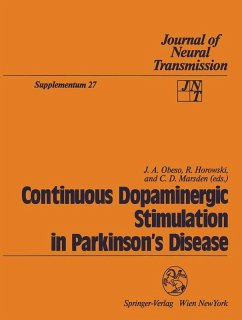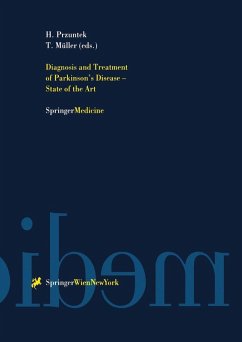
Cortico-Subcortical Dynamics in Parkinson's Disease (eBook, PDF)
Versandkostenfrei!
Sofort per Download lieferbar
80,95 €
inkl. MwSt.
Weitere Ausgaben:

PAYBACK Punkte
40 °P sammeln!
The striatum is the principal input structure of the basal ganglia. Numerically, the great majority of neurons in the striatum are spiny projection neurons, which produce the inhibitory output of the striatum to the globus pallidum and substantia nigra. The major glutamatergic afferents to the striatum from the cerebral cortex make monosynaptic contact with spiny projection neurons. The dopaminergic afferents from the substantia nigra also synapse directly on the spiny projection neurons. Thus, the spiny projection neurons play a crucial role in the input-output operations of the striatum by i...
The striatum is the principal input structure of the basal ganglia. Numerically, the great majority of neurons in the striatum are spiny projection neurons, which produce the inhibitory output of the striatum to the globus pallidum and substantia nigra. The major glutamatergic afferents to the striatum from the cerebral cortex make monosynaptic contact with spiny projection neurons. The dopaminergic afferents from the substantia nigra also synapse directly on the spiny projection neurons. Thus, the spiny projection neurons play a crucial role in the input-output operations of the striatum by integrating glutamatergic cortical inputs with dopaminergic inputs and producing the output to other basal ganglia nuclei. Anatomical observations made nearly 30 years ago suggested that inhibitory interactions among the spiny projection neurons of the striatum are very pr- able. Individual spiny projection neurons produce a local axonal plexus in the spheroidal space occupied by their own dendritic trees [1, 2]. Based on the GABAergic nature of these neurons and their synaptic contacts with other spiny neurons, several authors have proposed that the spiny projection neurons form a lateral inhibition type of neural network [3-5]. In the idealised concept of lateral inhibition, each output neuron makes inhibitory synaptic contact with its neighbours [5]. However, there are physical limitations set by the extent of axonal and dendritic trees, and the number of synaptic sites, which mean that lateral inhibition is limited to a local domain of inhibition.
Dieser Download kann aus rechtlichen Gründen nur mit Rechnungsadresse in A, B, BG, CY, CZ, D, DK, EW, E, FIN, F, GR, HR, H, IRL, I, LT, L, LR, M, NL, PL, P, R, S, SLO, SK ausgeliefert werden.












